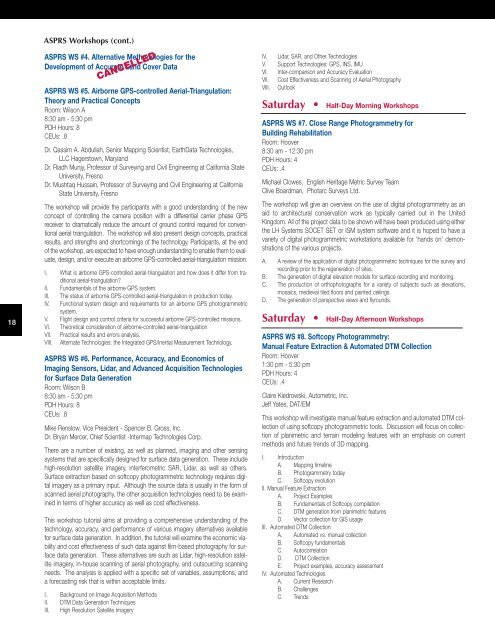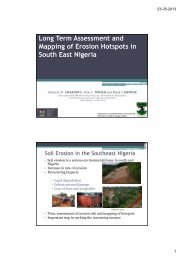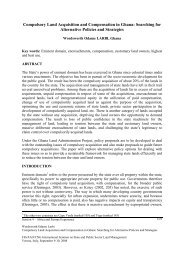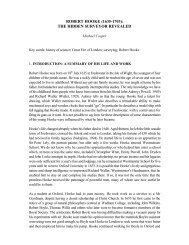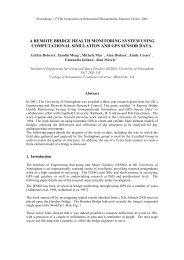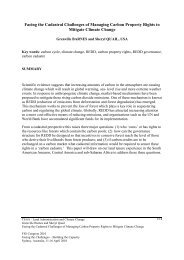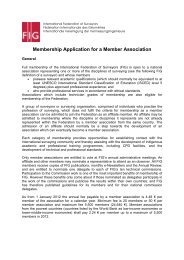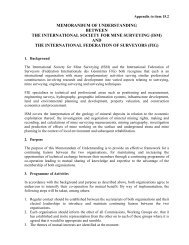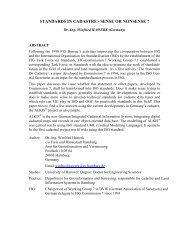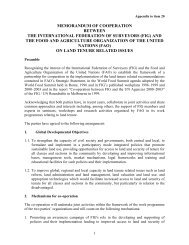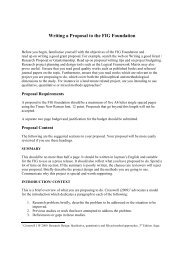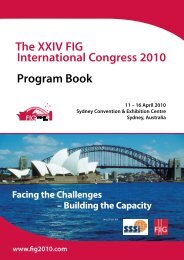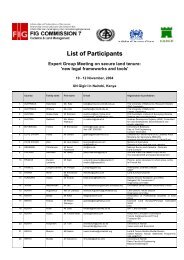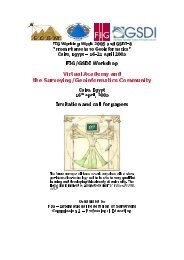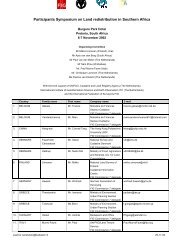Create successful ePaper yourself
Turn your PDF publications into a flip-book with our unique Google optimized e-Paper software.
18<br />
ASPRS Workshops (cont.)<br />
ASPRS WS #4. Alternative Methodologies for the<br />
Development of Accurate Land Cover Data<br />
CANCELLED<br />
ASPRS WS #5. Airborne GPS-controlled Aerial-Triangulation:<br />
Theory and Practical Concepts<br />
Room: Wilson A<br />
8:30 am - 5:30 pm<br />
PDH Hours: 8<br />
CEUs: .8<br />
Dr. Qassim A. Abdullah, Senior Mapping Scientist, EarthData Technologies,<br />
LLC Hagerstown, Maryland<br />
Dr. Riadh Munjy, Professor of Surveying and Civil Engineering at California State<br />
University, Fresno<br />
Dr. Mushtaq Hussain, Professor of Surveying and Civil Engineering at California<br />
State University, Fresno<br />
The workshop will provide the participants with a good understanding of the new<br />
concept of controlling the camera position with a differential carrier phase GPS<br />
receiver to dramatically reduce the amount of ground control required for conventional<br />
aerial triangulation. The workshop will also present design concepts, practical<br />
results, and strengths and shortcomings of the technology. Participants, at the end<br />
of the workshop, are expected to have enough understanding to enable them to evaluate,<br />
design, and/or execute an airborne GPS-controlled aerial-triangulation mission.<br />
I. What is airborne GPS-controlled aerial-triangulation and how does it differ from traditional<br />
aerial-triangulation?<br />
II. Fundamentals of the airborne GPS system.<br />
III. The status of airborne GPS-controlled aerial-triangulation in production today.<br />
IV. Functional system design and requirements for an airborne GPS photogrammetric<br />
system.<br />
V. Flight design and control criteria for successful airborne GPS-controlled missions.<br />
VI. Theoretical consideration of airborne-controlled aerial-triangulation<br />
VII. Practical results and errors analysis.<br />
VIII. Alternate Technologies: the Integrated GPS/Inertial Measurement Technology.<br />
ASPRS WS #6. Performance, Accuracy, and Economics of<br />
Imaging Sensors, Lidar, and Advanced Acquisition Technologies<br />
for Surface Data Generation<br />
Room: Wilson B<br />
8:30 am - 5:30 pm<br />
PDH Hours: 8<br />
CEUs: .8<br />
Mike Renslow, Vice President - Spencer B. Gross, Inc.<br />
Dr. Bryan Mercer, Chief Scientist -Intermap Technologies Corp.<br />
There are a number of existing, as well as planned, imaging and other sensing<br />
systems that are specifically designed for surface data generation. These include<br />
high-resolution satellite imagery, interferometric SAR, Lidar, as well as others.<br />
Surface extraction based on softcopy photogrammetric technology requires digital<br />
imagery as a primary input. Although the source data is usually in the form of<br />
scanned aerial photography, the other acquisition technologies need to be examined<br />
in terms of higher accuracy as well as cost effectiveness.<br />
This workshop tutorial aims at providing a comprehensive understanding of the<br />
technology, accuracy, and performance of various imagery alternatives available<br />
for surface data generation. In addition, the tutorial will examine the economic viability<br />
and cost effectiveness of such data against film-based photography for surface<br />
data generation. These alternatives are such as Lidar, high-resolution satellite<br />
imagery, in-house scanning of aerial photography, and outsourcing scanning<br />
needs. The analysis is applied with a specific set of variables, assumptions, and<br />
a forecasting risk that is within acceptable limits.<br />
I. Background on Image Acquisition Methods<br />
II. DTM Data Generation Techniques<br />
III. High Resolution Satellite Imagery<br />
IV. Lidar, SAR, and Other Technologies<br />
V. Support Technologies: GPS, INS, IMU<br />
VI. Inter-comparison and Accuracy Evaluation<br />
VII. Cost Effectiveness and Scanning of Aerial Photography<br />
VIII. Outlook<br />
Saturday • Half-Day Morning Workshops<br />
ASPRS WS #7. Close Range Photogrammetry for<br />
Building Rehabilitation<br />
Room: Hoover<br />
8:30 am - 12:30 pm<br />
PDH Hours: 4<br />
CEUs: .4<br />
Michael Clowes, English Heritage Metric Survey Team<br />
Clive Boardman, Photarc Surveys Ltd.<br />
The workshop will give an overview on the use of digital photogrammetry as an<br />
aid to architectural conservation work as typically carried out in the United<br />
Kingdom. All of the project data to be shown will have been produced using either<br />
the LH Systems SOCET SET or ISM system software and it is hoped to have a<br />
variety of digital photogrammetric workstations available for ‘hands on’ demonstrations<br />
of the various projects.<br />
A. A review of the application of digital photogrammetric techniques for the survey and<br />
recording prior to the regeneration of sites.<br />
B. The generation of digital elevation models for surface recording and monitoring.<br />
C. The production of orthophotographs for a variety of subjects such as elevations,<br />
mosaics, medieval tiled floors and painted ceilings.<br />
D. The generation of perspective views and flyrounds.<br />
Saturday • Half-Day Afternoon Workshops<br />
ASPRS WS #8. Softcopy Photogrammetry:<br />
Manual Feature Extraction & Automated DTM Collection<br />
Room: Hoover<br />
1:30 pm - 5:30 pm<br />
PDH Hours: 4<br />
CEUs: .4<br />
Claire Kiedrowski, Autometric, Inc.<br />
Jeff Yates, DAT/EM<br />
This workshop will investigate manual feature extraction and automated DTM collection<br />
of using softcopy photogrammetric tools. Discussion will focus on collection<br />
of planimetric and terrain modeling features with an emphasis on current<br />
methods and future trends of 3D mapping.<br />
I. Introduction<br />
A. Mapping timeline<br />
B. Photogrammetry today<br />
C. Softcopy evolution<br />
II. Manual Feature Extraction<br />
A. Project Examples<br />
B. Fundamentals of Softcopy compilation<br />
C. DTM generation from planimetric features<br />
D. Vector collection for GIS usage<br />
III. Automated DTM Collection<br />
A. Automated vs. manual collection<br />
B. Softcopy fundamentals<br />
C. Autocorrelation<br />
D. DTM Collection<br />
E. Project examples, accuracy assessment<br />
IV. Automated Technologies<br />
A. Current Research<br />
B. Challenges<br />
C. Trends


